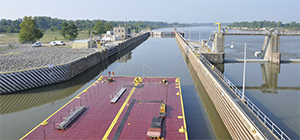Industry officials are pleased with the projects included in the Water Infrastructure Improvements for the Nation (WIIN) Act of 2016, which was passed by Congress in December and signed into law by former President Obama. However, they acknowledge that getting money for the work will be a big challenge.
The appropriations process is complex and project authorization does not guarantee funding. In the Water Resources Development Act of 2016 and the WIIN Act of 2016 — WRDA 2016 is included in WIIN — Congress authorized $22 billion in navigation projects, flood risk management and environmental restoration, according to a congressional aide in transportation. The annual construction budget for the U.S. Army Corps of Engineers is between $1.7 billion and $1.8 billion.
“We still have to get appropriations — that is a major push for us now,” said Jim Walker, director of navigational policy and legislation for the American Association of Port Authorities.
WIIN/WRDA 2016 includes the authorization of inland projects such as the Calcasieu Lock in Louisiana, with a 2014 estimated cost of $17.4 million, and the Upper Ohio Navigation System in Pennsylvania at a 2016 estimated cost of $2.7 billion. Half of the cost of both projects is to be covered through the Inland Waterways Trust Fund.
Harbor projects that have been authorized include the deepening of Brazos Island Harbor in Texas at a 2014 estimated cost of $210.5 million; the deepening and widening of the Port Everglades navigation channel at a 2015 estimated cost of $337 million; and the deepening of Charleston Harbor to 52 feet at an estimated cost of $502.7 million. The $107.2 million non-federal share of the Port Everglades project will be funded by customer fees and grants from the state of Florida, according to a news release from the port. The South Carolina General Assembly in 2012 set aside $300 million for the state’s share of the Charleston project, according to a news release from the South Carolina Ports Authority. The federal government is to pay the remainder of the cost.
A significant change in WIIN/WRDA 2016 was the return to a two-year process to handle water resources legislation. Between 2000 and 2014, legislation was only passed every seven years. “It’s crucial,” said Craig Montesano, vice president of legislative affairs for the American Waterways Operators. “You avoid a helter-skelter approach to funding. This has been put back in the regular order process, which makes everyone happy.”
Another victory for the industry was the elimination of a proposed public-private partnership that would have allowed private companies to rehabilitate or build locks and pay for it with lockage fees. “It is fundamentally unfair to expect one beneficiary group to be burdened with additional, potentially crippling and uncompetitive costs for the waterways system,” stated an April 2016 letter signed by 75 organizations including maritime companies, shipyards, industry groups and agricultural associations.
The industry has already stepped forward to help provide funding for navigation improvements, according to Mike Toohey, president of the Waterways Council Inc. The industry advocated for a 45 percent increase in the diesel fuel tax for commercial barge companies and their customers, which went into effect in 2015. Proceeds from the tax go to the Inland Waterways Trust Fund to be matched by public funds.
“We took that on voluntarily and went to Congress to help enact it, and we are very happy with it,” Montesano said.
The number of projects in need of appropriations remains a concern. There is a backlog of 13 projects in harbor and coastal regions, Walker said. On the inland waterways, 25 projects have been authorized but not funded, including four in the 2016 improvements act, according to Toohey.
“It is a struggle having to go after the funds each year,” Walker said. “We have to push to get sufficient funding to get these projects underway and get them built.”
Another hitch is that congressional earmarks for specific projects ended in 2011. It is now up to the president to decide which projects get funding. In practice, it has meant that smaller projects go first since they can get fully funded. President Obama tended not to fund large projects, Walker said.
“They’ve been holding back,” he said.
It also means that the industry and Congress are unable to predict which projects will be funded in the next administration budget.

